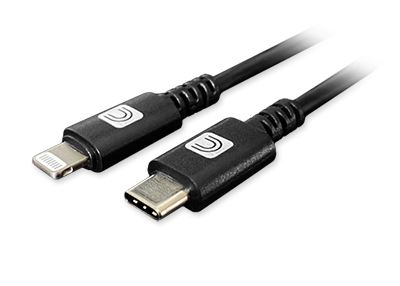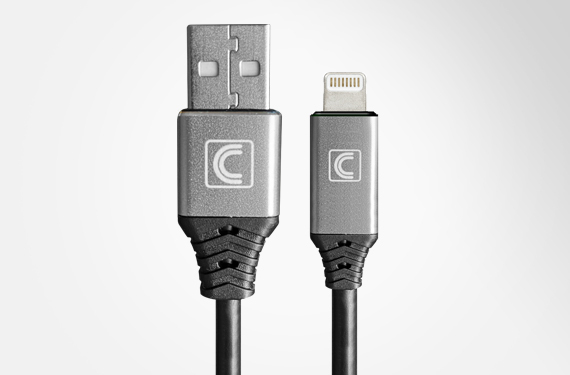Lightning is a proprietary computer bus and power connector created and designed by Apple® Inc. Introduced on September 12, 2012, to replace its predecessor, the 30-pin dock connector, the Lightning connector is used to connect Apple® mobile devices like iPhones®, iPads®, and iPods® to host computers, external monitors, cameras, USB battery chargers, and other peripherals. Using 8 pins instead of 30, Lightning is denser than its predecessor, which was integrated with devices like the iPhone® 4 and the iPad 2. The lightning cable may be inserted into the female port using either side. However, without an adapter, it is incompatible with cables and peripherals designed for its predecessors.
 The Lightning connector was introduced on September 12, 2012, as an upgrade to the 30-pin dock connector. It would soon be integrated with all new hardware and devices that was to be announced at the same event. The first compatible devices were the iPhone® 5, the iPod® Touch (5th generation), and the iPod® Nano (7th generation). The iPad® (4th generation) and the iPad® Mini (1st generation) were added as Lightning devices in October 2012.
The Lightning connector was introduced on September 12, 2012, as an upgrade to the 30-pin dock connector. It would soon be integrated with all new hardware and devices that was to be announced at the same event. The first compatible devices were the iPhone® 5, the iPod® Touch (5th generation), and the iPod® Nano (7th generation). The iPad® (4th generation) and the iPad® Mini (1st generation) were added as Lightning devices in October 2012. On November 25, 2012, Apple® acquired the "Lightning" trademark in Europe from Harley-Davidson. Apple® was given a partial transfer of the Lightning trademark, suggesting that Harley-Davidson likely retained the rights to use the name for motorcycle-related products. Apple® is the sole proprietor of the trademark and copyrights for the designs and specifications of the Lightning connector.
 The iPad® Pro, released in 2015, features the first Lightning connector supporting USB 3.0 host. However, the only accessory that supports USB 3.0 is the new camera adapter. Normal USB-A - Lightning cables are still USB 2.0.
The iPad® Pro, released in 2015, features the first Lightning connector supporting USB 3.0 host. However, the only accessory that supports USB 3.0 is the new camera adapter. Normal USB-A - Lightning cables are still USB 2.0.On October 30, 2018, Apple® announced that their new range of iPad® Pros would replace Lightning with USB-C.
What are the primary functions of the Lightning connector?
What are some devices that the Lightning connector can be found on?
Comprehensive's Apple® MFi Certified Lightning Cables are tested and certified by Apple's® MFi program to ensure 100% compatibility with all your Apple devices. Our Lightning to USB-C or USB-A Cables allow for both syncing and power charging. All of our Lightning Cables are covered by Comprehensive's worry-free Lifetime Warranty to ensure years of use.
A: Yes, Comprehensive manufactures a large selection of USB Cables, USB Hubs, laptop docking stations, USB Dongles and other USB devices.
Q: What are Lightning cables used for?
A: As of September 2012, Lightning cables are the standard connective for linking iPhones, iPads and iPods with chargers, host computers, screens and other peripherals. They’ve completely replaced the old 30-pin dock. Today, iPhone chargers generally come equipped with cell phone cables and a 5-watt charger. There is a better option though. With a 12-watt charger, you can power up your phone in half the time. With 12 watts, the iPhone 6 will take an average of one hour and fifty minutes to charge the battery, while an iPhone 6 Plus takes two-and-a-half hours.
Q: What is the difference between the Lightning connector and the USB Type-C connector?
A: The differences are the Lightning connector only supports 480Mbps data transfer speed and charging up to 12W while the USB-C connector allows up to 40Gbps data transfer speeds and up to 100W of charging.
Q: Are Lightning cables backwards compatible with my old device?
A: Unfortunately, the answer is no. You can still use a Lightning cable with an older Apple® product that used the 30-pin dock, but you’ll need to purchase an adapter to connect the two. Since the average lifespan of a smartphone is only two years, though, you’ll likely need a device upgrade sooner than later anyway. Adapters are also available for other connectors like USB cables and other peripherals.
Q: Is USB-C to lightning faster?
A: The latest iPhones and Android phones can charge at up to 18 W, and our tests show that an iPhone XR can get from 0 percent to nearly 50 percent in just 30 minutes with a USB-C charger and a USB-C–to–Lightning cable. That is a serious difference from the 35 percent a standard 12 W charger can do.
Q: Which is betterUSB-C or lightning?
A: Clearly, USB-C is much faster than lightning, although some believe that Lightning is not necessarily worse simply because it's slower. It's not usual to transfer big data files via mobile phones or other devices. Furthermore, you don't have to use a cable to transfer data.
Q: What devices use lightning cables?
A: Introduced on September 12, 2012, to replace its predecessor, the 30-pin dock connector, the Lightning connector is used to connect Apple® mobile devices like iPhones, iPads, and iPods to host computers, external monitors, cameras, USB battery chargers, and other peripherals.



